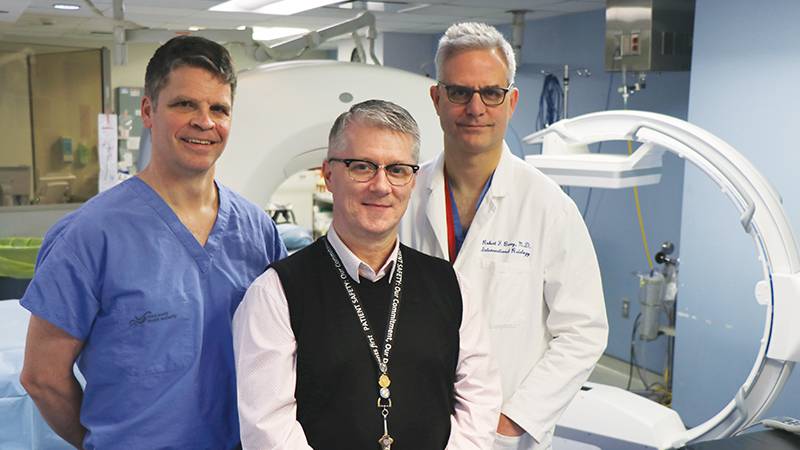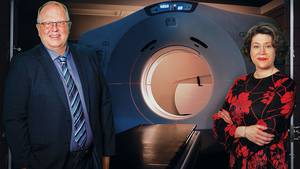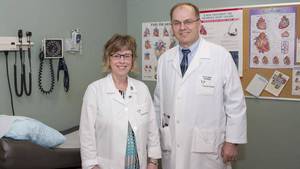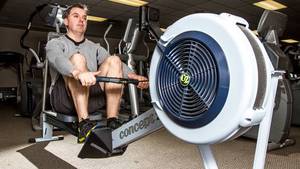Interventional radiology (IR) is one of the fastest-growing fields of medicine and the QEII Health Sciences Centre is making a big leap forward for patients who need such care.
IR is a medical subspecialty of radiology that uses minimally invasive image-guided procedures to diagnose and treat diseases in nearly every organ system from head to toe. On any given day, the QEII’s IR team may use X-ray guidance to pass a small tube through an artery to remove a stroke-causing blood clot, use CT guidance to advance a needle into a small liver tumour to destroy it with heat, or use ultrasound and X-ray guidance to pass a balloon through a blocked artery to restore circulation in a patient’s leg to prevent the need for amputation.
The precision of IR procedures reduces the need for large incisions (open surgery) in the body and can often be done with local anesthetic, improving recovery for patients.
Brian Martell, senior director of diagnostic imaging for Nova Scotia Health Authority, says the current care journey for IR treatment is confusing and stressful for patients.
Patients register on the fourth floor of the QEII’s Halifax Infirmary, get assessed by a nurse, transfer to the fifth floor for another assessment, get the procedure done and then return to recover on the fourth floor.
Brian says the new IR suites opening at the QEII’s Halifax Infirmary building in 2020 will bring “full-focus patient care” and everything will happen in one area. “A patient will come in and be cared for in one space,” he says.
The smoother system will provide a more efficient IR service.
“The whole experience will be less stressful and less confusing for the patient,” he says. “From start to finish, the interventional team will be taking care of the patient. The patient journey should improve dramatically.”
Dr. Rob Berry, head of interventional radiology, says the idea for the new suite started in 2015.
A patient will come in and be cared for in one space. The whole experience will be less stressful and less confusing for the patient. From start to finish, the interventional team will be taking care of the patient.
– Brian Martell
“We consulted with interventional radiology departments across North America to determine the best possible, most efficient setup we could to advance care for our patients,” he says. “What we ultimately came up with is building four new IR suites to replace the two we had and an 11-bed pre- and post-procedure area just for the IR patients.”
The new IR area will also have its own CT fluoroscopy scanner for performing CT-guided procedures. This will further reduce patient movement and free up time on the diagnostic CT scanners. “It’s a huge improvement for our IR patients and it’s also expected to impact wait times for patients in the emergency department who need diagnostic CT scans,” Dr. Berry says.
The team plans to start opening the new suites in spring 2020 and have them fully running by fall.
The work is part of the QEII New Generation redevelopment. The QEII Foundation is fundraising to provide the latest technology and equipment — CT fluoroscopy and mobile C-arm — for two of the suites, while provincial government funding will cover the remainder.
CT Fluoroscopy relies on image guidance to conduct interventional procedures. It is vital in the diagnosis of some cancers through biopsies, and can be lifesaving in the treatment of cancer through ablation, which involves inserting a needle into a tumour and killing it. A mobile C-arm hosts simple but vital image-guided procedures. It is most commonly used for IV placement in cancer patients.
Dr. Geoff Porter, a QEII surgical oncologist and head of general surgery, says interventional radiology is a critical component of his work as a cancer surgeon. He says IR has been steadily moving forward over 30 years, allowing more and more patients to avoid surgeries.
“Initially, interventional radiology had a major focus on biopsies and dealing with complications after surgery that traditionally would have required a whole new operation,” Dr. Porter says. “Now, more and more IR-delivered primary treatments are available with great benefit to patients.”
He says surgeons, oncologists and interventional radiologists work as a team; the new IR suites will let them all play on the same field. Dr. Porter says it will be easier for medical professionals to talk about cases when they’re near each other and it will improve patient care by keeping everything in one place.
With the new IR suites on the horizon, Brian notes that a significant amount of planning was necessary. Vicki Sorhaindo, IR manager, along with many staff and physicians collaborated on the best plan to benefit patients today and into the future.








